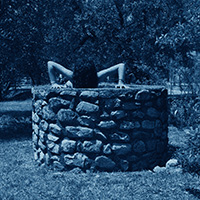The Terror Tourist: The Ghosts of Colorado

Episode 188: Creepy Crawlies – Heavy Leather Horror Show
The Terror Tourist is my occasional segment on the Heavy Leather Horror Show, a weekly podcast about all things horror out of Salem, Massachusetts. (Segment begins at 12:12, but you’ll enjoy the whole thing!)
Hail and well met, travelers! I am your guide, your troubadour of horror, for The Terror Tourist — an itinerary of dark destinations, a travelogue of dread, a must-see list of ghastly locales worldwide. Each episode we’ll explore a new place — real or imagined, geographical or psychological. With these surveys of the macabre as inspiration I encourage you to strike out and blaze your own trail through the darkness!
Today our journey takes us through the state of Colorado, a rectangle of diverse vertical and horizontal lands in the Mountain West of the United States. While your association between Colorado and horror may begin and end with the music of John Denver, I assure it is so much worse. Let’s go for a hike!
Millions of years before it was known as Colorado this land was covered by a great inland seaway plied by the most terrifying creatures ever to make water their home. Take Xi-PHAC-tin-us, the 24’ long angular death machine the inside of whose serrated maw would be the first you ever saw of it and the last sight of your sorry life. Or the fierce mosasaur, a 50’ long monstrosity whose thirds were essentially giant crocodile, whale, and eel — and which even the largest sharks gave a wide berth. None of these creatures survived the meteor impact of 66 million years ago, you may be grateful to know, but their fossilized skeletons — and teeth, so many shed teeth! — form a rich, literal foundation of terror beneath your hiking boots in this land we now call Colorado.
You might have noticed the signpost at the trailhead for all the supernatural destinations upcoming. We’ll get there soon enough, but, sadly, there are plenty of waypoints of real life horror I want to note here for your future exploration:
In the 19th century colonizing settlers waged a genocidal campaign against the native inhabitants of the lands here, culminating in the atrocity known today as the Sand Creek Massacre. I will not provide detail except to say 1) This slaughter was actually praised in histories and monuments as an act of near-inevitable nation-building until shockingly recently and 2) The belief in Manifest Destiny has justified more horrific acts than the sum of every movie this podcast has or ever will review. (As an optional detour, I point you to the film Blood Quantum, which centers the Native American experience during a zombie apocalypse. Though set in Canada rather than Colorado it is a most creative reimagining of the concept of an Indian reservation.)
You’re not cold are you? You did dress in layers for this hike, right? See, it’s not just human behavior to fear here. The state itself seems to have it out for you. The most 14,000 foot-plus mountains in the continental US of course delivers brutal cold, blinding snowstorms, avalanches, piercing winds, and deliriously low levels of oxygen at altitude. Oh it’s also super dry, so you’ll dehydrate if all the other things don’t get you first.
Did you hear that? That rustling in the underbrush? Don’t panic. Apex predators have mostly been sacrificed at the altar of industrialized agriculture, but we do have bears (sorry Ken, no grizzlies though!) and just recently the gray wolf was reintroduced as an experiment in ecological rebalancing. Moose and elk can kill you by sheer size, but they don’t necessarily want to kill you. Actually moose might. The tip here is to walk noisily. Most animals don’t want anything to do with you … unless you sneak up on ‘em and they get startled.
You may think we’re hiking through the middle of nowhere. But a lot of these places were once raucous somewheres. Only to eventually become ghost towns. Hundreds of ghost towns, from piles of rubble barely discernible in the brush to actual towns full of rotting structures seemingly frozen in time, dot the landscape. Of course ghost towns are spooky, full of memory and loss — ready set-pieces for tales of actual ghosts. Surprisingly few films to my knowledge have actually used these locales at least in Colorado.
For me, what’s more interesting to ponder is why these booming burgs went bust. Usually it’s some sort of sudden resource scarcity — like the gold veins went dry, or the silver market crashed — or a technological change — a new rail line bypasses the town or a new road with a better grade makes it easier to get someplace else. The idea of these places grimy with miners, entrepreneurs, charlatans, prostitutes and barkeepers one day — and then nothing virtually overnight is the real scare for me. Our market economy is a cheery midwife and a merciless executioner.
There are two can’t miss destinations coming up before our journey ends.
Let’s walk back in time to the mid 19th century on the outskirts of the booming new city of Denver. About 160 acres of land is set aside as Mount Prospect Cemetery just southeast of the central business district and what would become the state capitol. And just as Denver is swelling with people coming to the Rockies looking for gold, silver, and a new life, the city cemetery is swelling with those who instead found disease, bullets to the head, and death. By 1898 there are about 5,000 bodies in the dirt here, but times are changing in urban design and this is era of the City Beautiful movement where parks, leafy boulevards, and neoclassical design are all the rage in proving that your city is to be taken seriously. So Denver wants to turn the cemetery — no longer on the outskirts of the growing city — into a beautiful new park. Surely you see where this hike is headed, fellow traveler.
The city undertook the task of moving the 5,000 graves, but the effort was bungled from the start. The movers were paid by the coffin so enterprising gravediggers would dismember corpses and shuffle parts into smaller, more numerous child-sized boxes. When the city discovered this, they dismissed the whole crew and admitted they were out of money to move the remaining 2,000 bodies. The city gave family members a few weeks to claim bodies, but as many of these graves were of the indigent and unclaimed victims of crime, few people came forward. So, the park conversion continued, bodies still in the ground. (Sidenote: the segregated far southwest of the cemetery filled with the corpses of Chinese immigrants who came to help build the transcontinental railroad was dutifully disinterred by the small Chinese community here and all bodies shipped back to China.)
Walk with me over here and, if our location and the angle of the sun is right, you can still make out divots in the rolling hills of the park where the graves have ever-so-slightly subsided. Every day, not two blocks from my house people lounge and dogs run about oblivious to the corpses beneath the picnic blankets and volleyball nets. Part of the former cemetery, now called Cheesman Park, was given over to create the Denver Botanic Gardens whose construction expansions over the years continue to unearth graves and corpses — most recently in 2022. Ghost stories in this park, unsurprisingly, are plentiful. I’m willing to believe.
There’s an unsubstantiated rumor that the unmoved graves and subsequent development of this park was an inspiration for Poltergeist. Who knows? What is substantiated is the story behind the 1980 film The Changeling, which takes place in a mansion that directly sat on Cheesman Park. Starring George C. Scott trying his hardest not to be irascible, this classic haunted house film was inspired by a story written by a composer named Russell Hunter who was renting the Henry Treat Rogers House in 1968. His recounting is nearly identical to the story in the film: bouncing balls in hallways, a sealed-over door leading to a hidden room, the discovery of a diary from a person locked away from public view, a psychic medium, and ultimately the revelation of the child-swap. The Denver Public Library has tried to verify any part of this tale — to no avail. But it made its way to film and a great one at that! The mansion was demolished in the 70s for a sad high-rise condominium building. Poltergeist and The Changeling — this park has something for everyone, I tell you!
The final stop on our hike brings us to the unavoidable importance of Colorado to Stephen King’s and Stanley Kubrick’s very separate masterpieces called The Shining. Up in the mountains here in a small town called Estes Park is a gorgeous old hotel called The Stanley. Originally created as a retreat for wealthy Easterners suffering tuberculosis and other ailments, the hotel eventually became a high-end stopover for tourists on their way to Rocky Mountain National Park, established in 1915. Given the massive amounts of snow at elevation the hotel was only open in the summer months (until 1983). But back in 1974 the author Stephen King, coincidentally, happened to book a room at the Stanley the day before it was being shuttered for the winter. He roamed the halls of the near-desolate hotel, had a drink at the bar with a bartender named Grady, and spent the night in room 217. The rest is mostly history, though of note to those who know the sizable differences between the book and the film, The Stanley did actually partially explode in 1911 due to a gas build-up. Clearly King learned this during his stay, providing him with the novel’s conclusion.
The hotel itself is in no way scary. I’ve stayed there several times and it is just a beautiful, Federalist-style set of buildings that seem more at home on the east coast than the mountain west. If you’ve seen the terrible 1997 miniseries of The Shining directed by King (or the 1994 film Dumb and Dumber) then you have seen The Stanley. No hedge row labyrinth, no art deco ballroom, really nothing but the original bar that evokes dread. For decades the ownership of the hotel shied away from its associations with the book and film, especially since none of the latter was filmed there. But eventually they came to embrace the notoriety, planting their own very short hedge maze, offering Shining tours, and even now throwing an annual Shining Ball (which I have attended). But hotel management is all in now: in a partnership with the horror film production company Blumhouse the hotel is building out a 80,000 square foot film center and museum devoted to horror cinema. It should be open in a few years. I want to work there.
As for the other Stanley, Kubrick, he didn’t have much use for Colorado in his film. Not only was it not filmed here but even the one location-specific reference in the film — the story of the Donner Party that Jack recounts to his family on the ride up to the hotel — takes place in California. There’s a brief establishing shot outside the Torrance’s Boulder apartment — still there looking the same right next to the University of Colorado — but that’s it!
As terror tourists, however, you will likely care to know that Kubrick did use much of the mountain west as inspiration. He cribbed the design of the lobby and Native American iconography from the Ahwahnee Hotel in Yosemite National Park in California (for real, like down to the location of individual light fixtures), gathered exterior shots from the Timberline Lodge atop Mount Hood in Oregon, filmed the opening title sequence at Going-To-The-Sun Road in Montana’s Glacier National Park, and maybe even stole the red bathroom from the Biltmore Hotel outside Scottsdale in Arizona. That said, 98% of the film was shot on a soundstage at Elstree Studios north of London.
This is where I leave you to hike on your own, listeners. There are plenty of other sights for you to explore of course. I’ll note the excellent The Black Phone from 2021, set in 1970s Denver, the Day of the Dead remake from 2008 which isn’t awful, and the unrated Snowbeast from 1977 set in Crested Butte, Colorado. This film is awful in the very best way possible. I highly recommend it.
Good luck on your travels. Remember to hydrate and stay wary!
The Ampcamper How-To
This is a tale of towing a camper trailer 4,000+ miles with an electric vehicle.
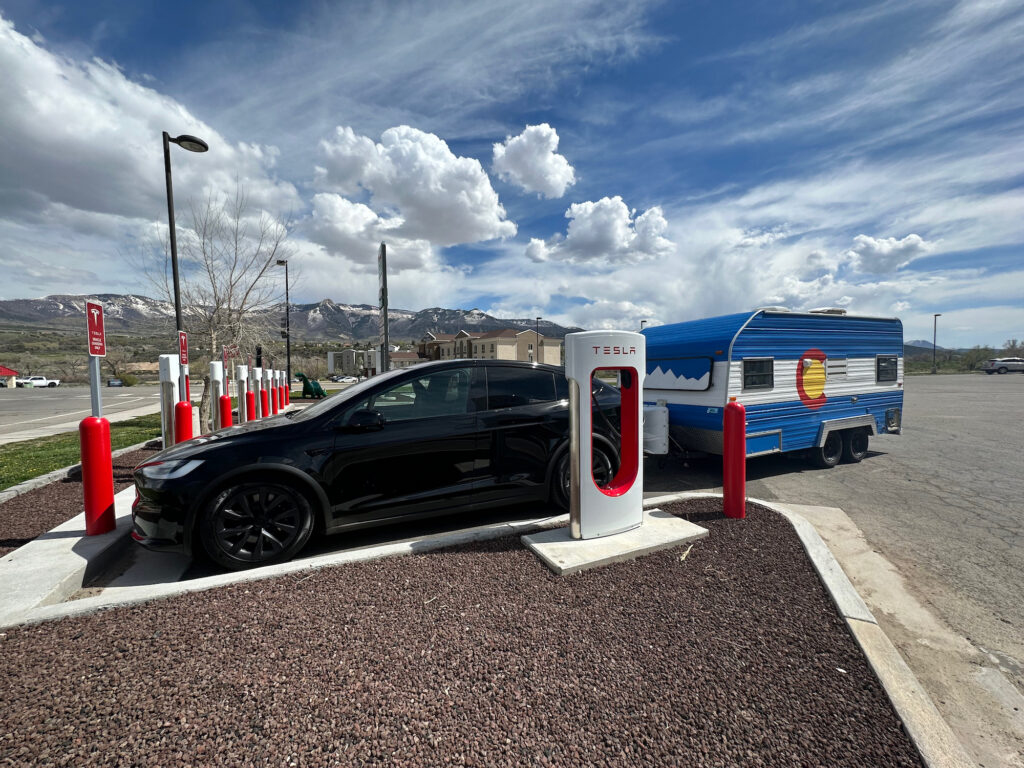
When the summer vacation idea to tool around the Western USA in an RV first was hatched it was pretty traditional. We didn’t own an RV, so we’d rent one, probably a big gas-guzzler that we’d drive around like a bus. But as I started thinking about how I liked to roadtrip — which is to say, stopping at every World’s Third Largest Ball of Twine I come across — a big rig seemed impractical. I would have chosen towing out of the gate but I couldn’t quite get over the downside that we’d all be trapped in a car for large parts of the trip. Eventually the tow setup won out when my college roommate offered his 30-year-old (but redecorated!) Sunline trailer. Seventeen feet of old school camper trailer — for free. I was in.
I knew that my Tesla Model X could tow up to 5000 lbs (about twice the Sunline camper GVW empty) so that wouldn’t be a problem. And thanks to a drunk driver in January destroying my previous car I had a relatively new Model X with 75 miles more range, 350 miles total. This seemed like the perfect setup … except for the charging.
The charging was worrisome for a bunch of reasons:
- All Level 3 DC fast chargers (what Tesla calls “Superchargers”) require you to back in to the stall for charging very close to the terminal, something impossible to do when towing anything . As far as I can tell this is because the amperage flowing through the very thick cable disallows the length needed to charge a car pulled in front-first. (Or at least degrades the throughput so much as to make it not as fast.) Tesla occasionally puts a single charging stall perpendicular to all the others for the very situation I would be in: towing something that prevents backing in. But these perpendicular stalls are very rare and often occupied by people who simply don’t want the hassle of backing in.
- Given our schedule I would need overnight Level 2 charging (what Tesla calls “Destination Charging”). Many hotels have this; almost no campgrounds offer this. We weren’t staying in hotels.
- Most of the states we would be visiting are electric vehicle charging wastelands, Montana and Wyoming in particular. There are many reasons for this — lack of density, red state love of the internal combustion engine, and basic market dynamics — so I knew even if the perfect setups existed they would be few and far between.
- National parks themselves are fairly bereft of infrastructure, period. That’s part of the point. Very large parks (like Yellowstone) actually do have some gas stations and recently Rivian has started installing Level 2 chargers at some in-park lodging (such as The Ahwahnee in Yosemite), but for the most part once you’re inside a national park you are off the grid quite literally.
So how did we do it?
For the Level 3 (on-the-route) fast charging we had backup plans upon backup plans. I visited every Streetview image I could find for every possible DC charger with 175 miles of main destination points (sites or campgrounds). Sidenote: using a site called Smappen I created somewhat beautiful “chargeshed” (not a word, made it up) maps showing me roughly how far I could get before we were doomed.
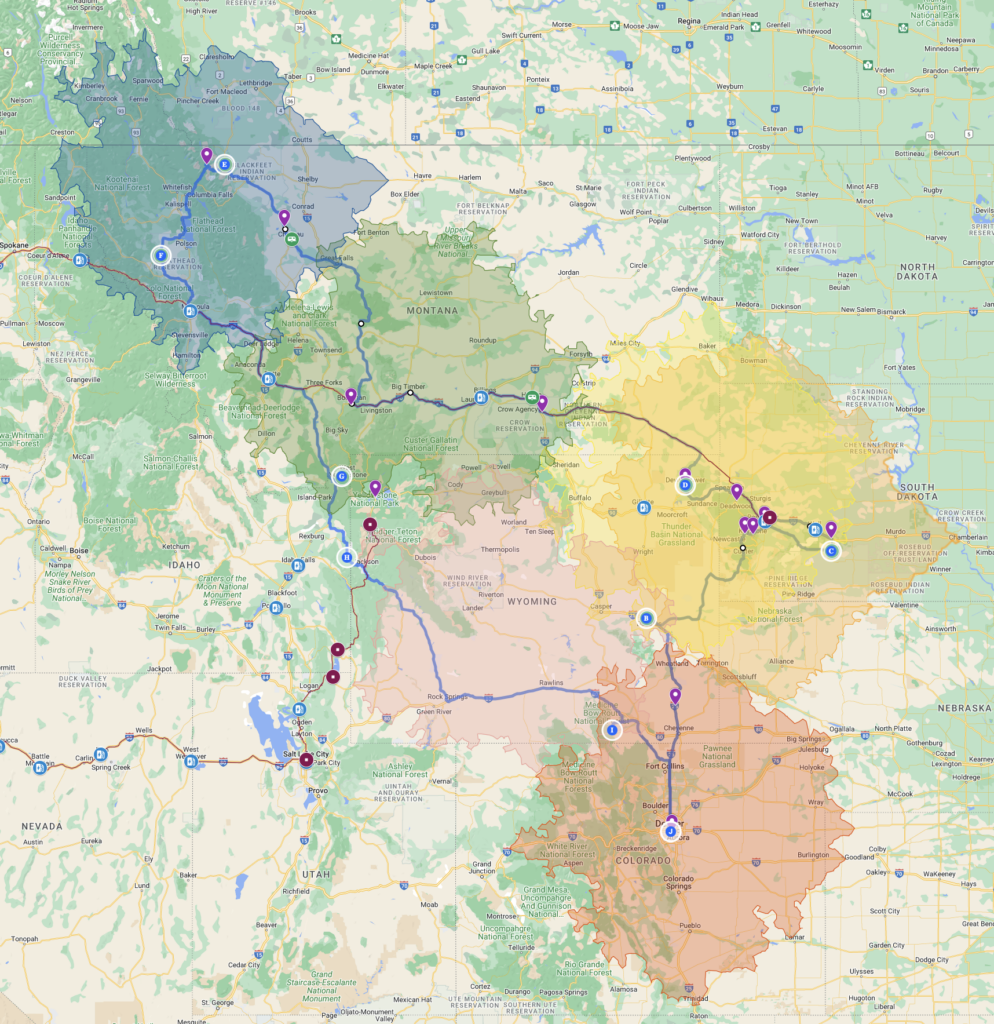
So from those Streetview images I knew the physical layout of every possible charging stop. This enabled me to plan for one of the following scenarios:
- Pull into a perpendicular charger (photo above), showering praise on the gods of electricity. There were maybe three of these total on the route.
- Pull forward past the chargers if no curbs or bollards were present. Only the oldest charging stops have no curb and I only ever encountered such a setup on a test run. None on the actual trip.
- Pull parallel across a bunch of empty stalls like a complete asshole. This only works in specialty situations when no one is charging and there is a ton of extra room to the left of the leftmost stall. You obviously can’t leave your vehicle if you do this, since others could show up and need the chargers you are now blocking. I did this a few times like a complete asshole.
- Unhitch. The option of last resort. We were forced to do this a bunch of times, though by the second week my daughter (“The Hitch Bitch” thank you very much) and I were as fast as a Formula One pit crew getting the rig unhitched and hitched back up.
In total we charged 31 times at Level 3 chargers, all Tesla except once at an Electrify America station. The latter are rolling out slowly, but if you can get a “Hyper” stall they charge even faster than the Tesla Superchargers.
Of note is that I almost never performed a full top-up at these stops. Pretty quickly I came to understand exactly how far I could go in most terrain towing our load. The car is rated at 350 miles with a full charge. On two test runs I basically calculated that range was cut in half towing, so 175 miles. This obviously was variable based on elevation increase and decrease (and headwind/tailwind, but c’mon), but the car itself started recalculating range based on “knowing” that we were in Tow Mode. It was fairly accurate, but to be extra safe I was mentally calculating that I would need 3x of the total distance to my next charge. If you’re doing the math at home this means that I would not schedule any stop further than about 110 miles out, even though I probably could have. This worked … until it didn’t.
We were ¾ of the way from Hot Springs to West Yellowstone, Montana, the second longest run of the trip, beautiful but empty. We juiced in Butte and, according to the onboard calculation, were set to make it on the wattage equivalent of fumes. But something didn’t seem right. There was a 2000’ elevation gain between us and Yellowstone that I wasn’t sure the onboard range calc was factoring in. With no towns at all en route the only solution was to find something, anything that would give us at least a 220v connection. (I refused to consider plugging into a 110v outlet — what’s known as Level 1. We’d be there charging for days.) Short of stopping at someone’s home and asking to use their washing machine electrical hookup connection (don’t laugh, we did that — more on that below), the only option was to find an RV campground.
And here we have the real hack of the trip. RV campground power is really what made it all work. You could argue that RV campgrounds exist in the first place for only two reasons: they provide a place for recreational vehicles to receive power and to dump waste. In test runs prior to the trip I confirmed that with the appropriate physical adapter I could adequately achieve a Level 2 charge overnight from a normal 50 amp RV hookup. Even better, most campground pedestals provide two connections — one for 50 amps and one for 30 amps — so I could also power the camper (though I brought a splitter just in case).
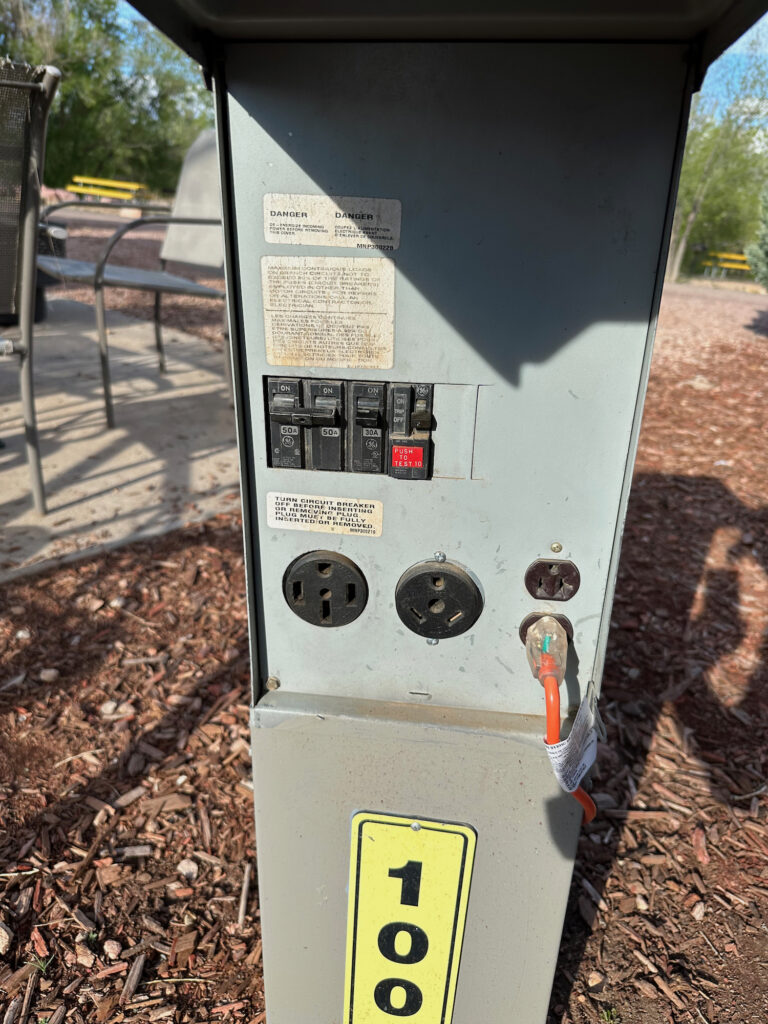
So this was the solution for a little extra juice on the uphill run to West Yellowstone. We found an RV campground en route (ahem, the only RV campground en route) and pulled in. It was almost full but the office was closed and the whole park was strangely devoid of people. I think a storm had just passed through and everyone was still hunkered in their campers. We found an empty stall, hooked up, and started charging. Problem solved.
I didn’t invent this hack. People have been charging electric vehicles at RV campgrounds as a last resort for a while, but usually this is done without an accompanying recreational vehicle behind the EV — a sure tip-off to campground management that you’re not paying for the privilege. The big campground companies, like KOA, have caught on and have official policies forbidding charging electric vehicles from RV pedestals. They even say you can damage your vehicle doing so. And yet, I hooked a voltmeter to a pedestal on a test run and saw nothing out of the ordinary. And I trusted my car to prevent catastrophe from an unstable connection. (I had in the past experienced this trying to do Level One charging at a very old house with wonky wiring. The car detected it immediately and said nope.) A very few campgrounds do actually provide Level 2 chargers, but these are completely separate from the camping slots (requiring unhitching and unloading, boo).
And that’s really, simply how the trip happened: every night at our campgrounds we charged the car fully via the RV electrical pedestal (Level 2). We did this 25 times.
Importantly charging this way requires the 50 amp connection. 30 amp will take far too long. I’d advise having a splitter just in case as in at least one instance we shared a pedestal with the RV next to us. No campground employee ever made us disconnect and I am certain we were noticed. Hard to miss the sole electric vehicle in the park towing an old camper painted like a Colorado flag. Indeed, lots of campground folk would come to our site and ask how we were doing it, but they were more interested in the towing performance than our charging travails. To everyone other than the corporate management of RV campgrounds charging an EV like you’d juice up your camper battery just makes sense.
There’s such crossover potential between RV communities and EV owners. To some degree if you own a motorhome or a camper trailer you plan your route based on the availability of electricity. Where to power/recharge at night is a factor in planning, even though most rigs can boondock off-grid for a few days. Not only that, most experienced RV people have developed at least a rudimentary understanding of matters electrical (adapters, voltage vs amperage, etc). As the federal government looks to provide incentives and investment for the build-out of charging infrastructure, I suggest focusing some of the attention on RV-friendly communities. They already have the knowledge and some of the infrastructure. I have no data to back this up, but my guess is that culturally these are some of the most gasoline-loving communities in the nation … with the twist that they know first-hand how important electricity is to their lifestyle.
The tipping point in the RV/EV crossover may be the widespread availability of bidirectional charging. Bidirectionality is the ability of a vehicle to provide its battery charge externally — to a power strip, a home, or even to another vehicle or camper trailer. Annoyingly Tesla does not do this (except to power the brake/turn/running lights on the camper), but the new Ford F-150 Lightning does. And there sure are a lot of regular F-150s in an RV campground. Boondocking potential aside, it makes sense that a camper trailer setup has a single battery source. You plug in at the campground and everything charges at once. Add some intelligence into the connection and you could programmatically make sure that you never use too much juice in-camper to prevent the vehicle range needed for the next day.
The RV/EV crossover has not really begun (though there are attempts), but it will and I think there will be no looking back. Campgrounds must see the writing on this particular wall. The good news is that there really is no need to install separate EV charging stalls at campgrounds. The wiring is already there. What campgrounds need to figure out is their total electrical capacity and the financial model to make it feasible.
A few final notes. One night we used Harvest Hosts — basically Airbnb for RVs where a farm, ranch, winery, etc offers one or two slots for overnighting. Generally these hosts do not have traditional hookups. We stayed at the lovely Ring of Horns bison ranch whose owner allowed us to run a very long extension cord and 220v adapter into her house to take advantage of her washer/dryer connection. I travel with a trunk full of extenders and converters so this wasn’t a problem. But you need an accommodating host (and some washer/dryer setups run off of 110v so your mileage may quite literally vary).
You may be wondering where solar power was in this Rube Goldberg setup. I considered it, but solar at the scale of photovoltaic panels that a vehicle or camper can accommodate just won’t do it at this point, especially since no vehicle I know of can charge while driving (i.e. when the sun is shining) and most charging needs to happen when parked overnight.
Again, towing was not an issue. It was smooth and uncomplicated, apart from one hiccup in automatic range calculation. Given the torque of electric vehicles with no real drive train I did dial the acceleration back just to take some strain off the hitch. And of course no autopilot, because I barely trusted myself to pilot this rig let alone the car AI.
We traveled 4,192 miles (approximately the distance from Honolulu to Chicago) and consumed 2,134 kilowatt-hours of power (approximately the average consumption of a typical American home over two months). The majority of this electricity was generated using fossil fuels, I’m quite certain. But with 2.5x the miles for electricity created from fossil fuel versus what you’d get burning it in an internal engine, I’m pleased with our footprint. Plus, zero emissions. Feels good to be inside a national park and know you’re not contributing to anthropogenic climate change — at least at that very moment.
Would I do this again? Absolutely if I could solve the Level 3 back-in problem. There are some sketchy after-market extensions available, but I am dubious as actual electrical engineers in the comment sections of these products basically say absolutely do not do this. But if a real, tested solution appeared I would roadtrip like this again in an instant. Less important, though ideal, would be owning a vehicle that allowed real two-way charging. I’d love to not worry about two batteries on a roadtrip.
And that’s how I hauled myself, two teen girls, an 80 lb dog, and a whole load of crap across six states in twenty days using an electric vehicle.
Day Twenty – Home
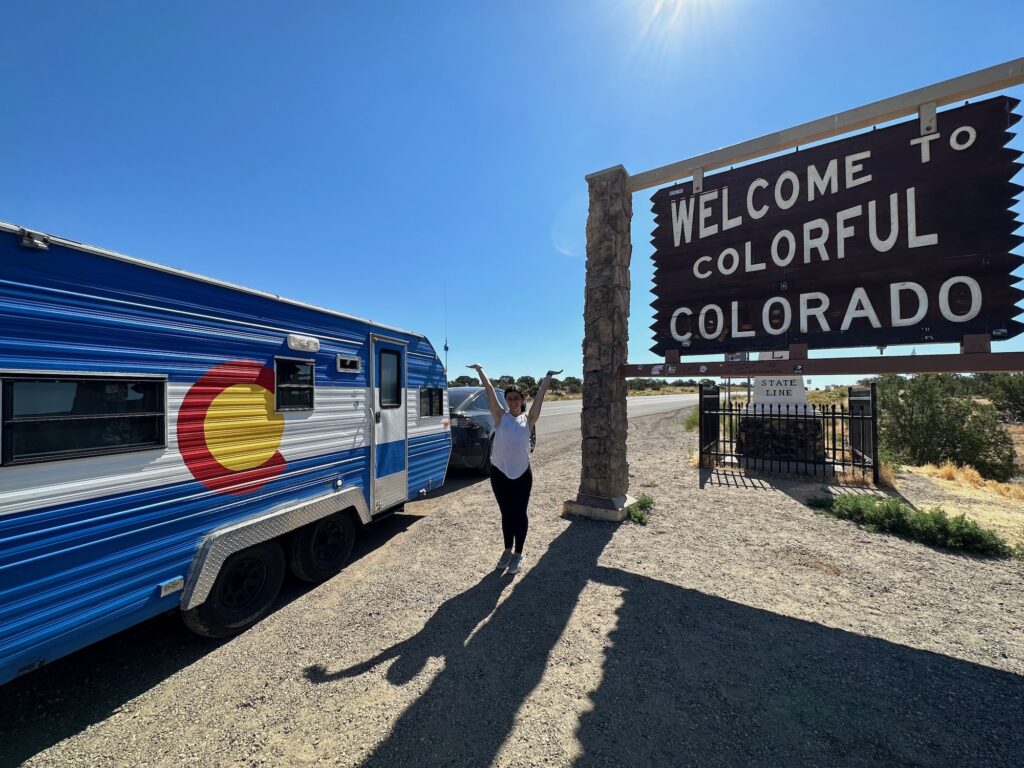
4,192 miles traveled. 2,134 kilowatt-hours used. 2,013 photos. 117 videos. 6 states. 5 national parks. 0 carbon emissions.
What an epic adventure. It’s going to take me a while to synthesize the last 20 days (but I will — so much more to say than my nightly missives). Many thanks to all who followed along!
Day Nineteen – Hoodoo Gurus
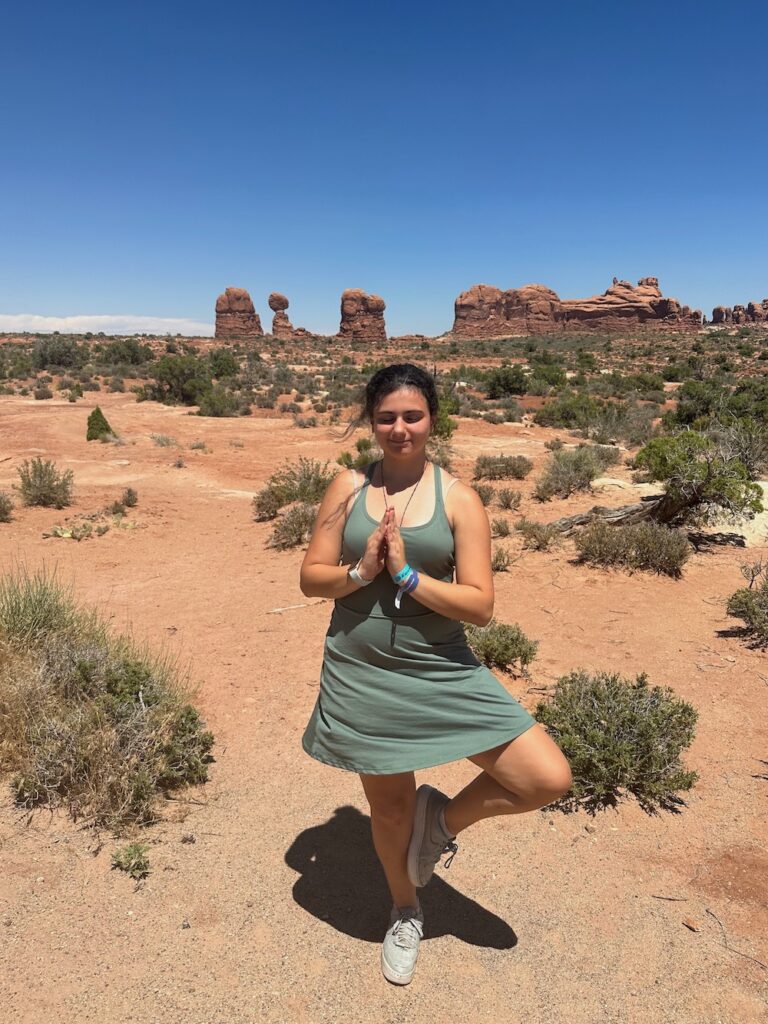
Just my daughter, dog, and I now so we took a day in Moab to ease down before the final journey home tomorrow. I finally emptied the trailer’s gray water (no Cousin Eddie “shitter’s full!” moment as we successfully avoiding pooping in the camper), though you can still smell the tank from 20 yards away. Which was fantastically nauseating in today’s 100° heat. But we were detached and touring around so no stank for us.
We try to pair the majesty of national parks with good low-brow tourist experiences so we started at Moab Giants, basically an outdoor park filled with fiberglass dinosaurs and “museum” buildings of fossil casts. How was it? Well, only four of the nine screens in the 5D Paleo Aquarium exhibit and the volunteer docent was completely phoning it in. Which is about what we expected. They had a mock fossil dig pit, which we haughtily avoided having dug for the real things last week. Fairly up-to-date dinosaur models, though. Some feathers, no tail-dragging. B- overall.
From there to Arches National Park. Though Utah has a ton of national parks and it’s only right next door, this was my first there. Lots of visitors not prepared for the heat (or hiking), but we managed and were generously rewarded. Every turn and vista is stunning, the sandstone carved by erosion into seemingly physics-defying contortions. Having looked at so many things that operate in spans of millions of years (dinosaur evolution, tectonic upheaval, etc) it was refreshing somehow that these arches come and go on the order of thousands of years. Live fast, die with a thundering crash to the ground.
Our last treat to ourselves after this epic trip was an air-conditioned theater and a viewing of the final Indiana Jones film. Fitting in some ways that such a precisely planned trip winds down with improvisation. As Indy says “I’m making this up as I go.”
Next up: home.
Day Eighteen – Roadsnacks


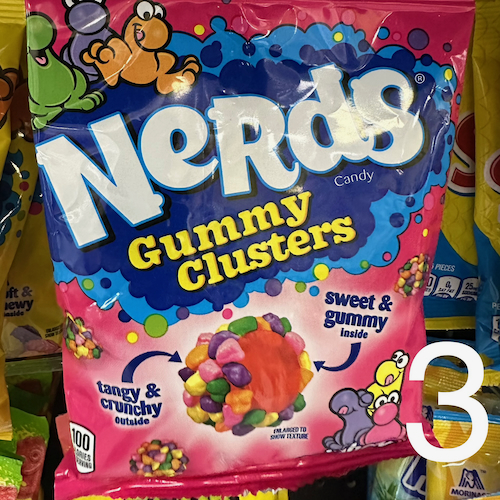
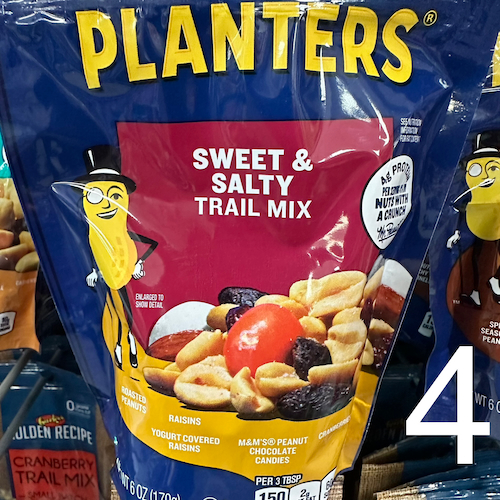
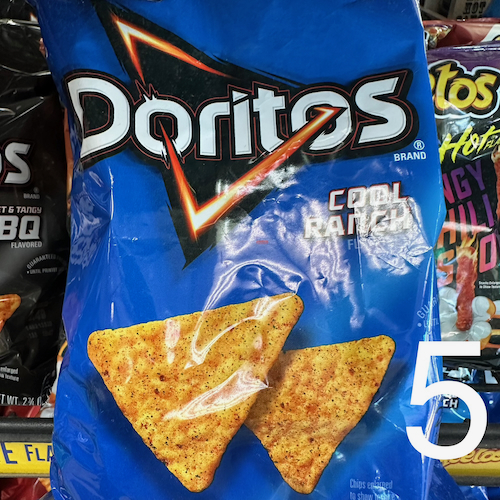
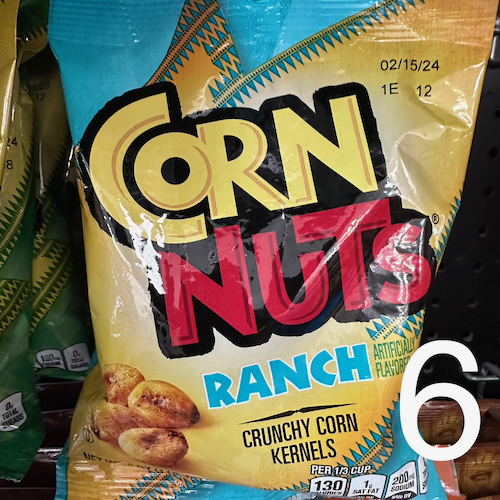

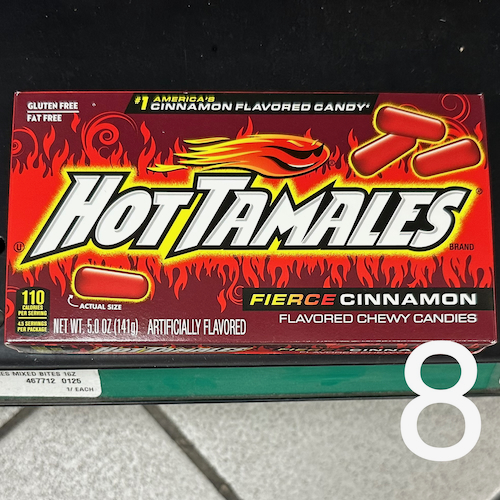


Nothing but driving today pre-dawn until late at night: Grand Teton to Moab. We’re more than halfway home. But first, we urgently need your help to settle some festering disagreements about appropriate roadtrip snacks. Which of these three belong in the car? Please rank in the comments. (Example: 3, 2, 10)
Update: Voting is now closed.
Final results as of July 6, 2023, 11:35 PM MT:
| Rye Chips | 13 |
| Haribo Peach Gummies | 7 |
| Nerds Gummy Clusters | 5 |
| Sweet & Salty Trail Mix | 17 |
| Cool Ranch Doritos | 14 |
| Corn Nuts (Ranch) | 7 |
| Reese’s Mini Peanut Butter Cups | 14 |
| Hot Tamales | 6 |
| Junior Mints | 6 |
| Salted Nut Roll | 1 |
Day Seventeen – Red, White, and Blue State
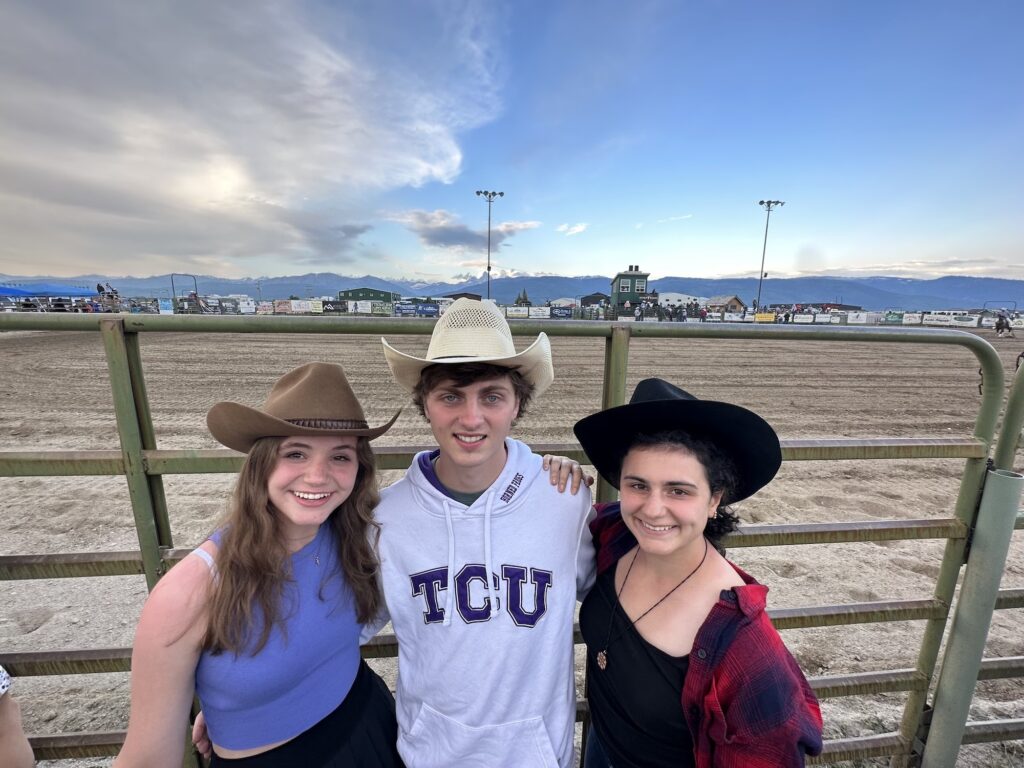
My teen July 4th celebrations mostly happened in and around the small town of Galena, Illinois in northwest Illinois. My memory of this is punctuated by 5K races, rural main street parades, rodeos, and lots of fresh fruit. So it was a real pleasure to approximate that experience again in tiny Victor, Idaho today. We walked to the main/only drag here for the festivities which kicked off at 10:30a. It was all blaring fire trucks, classic cars, some local dance troupes, and a slew of rural services with cool vehicles. In a twist I don’t remember from Independence Days past all the floats tossed candy to kids lining the way. A rescue helicopter even buzzed along the street a few times. And of course huckleberry-themed everything, including an actual crew of dancing huckleberry milkshakes. Really pretty impressive for a town of not even 2000 people. And, surprisingly, it was all fairly politically neutral. No effigies of POTUS or shooting of actual weaponry.
Went for a dip in the local swimming hole to cool down, chuckling the whole time that the pond is considered an HOA amenity. Some of us also made a game-time decision to visit the local Teton Valley Rodeo outside of Driggs, Idaho. This was especially nostalgic for my kids and niece who have very fond memories of July 4th rodeos in Galena with my parents. No clowns at this event — I’m not entirely sure how they were protecting riders — but the whole thing seemed less about entertainment per se and more just a normal sporting event. Most of the crowd knew people competing and were cheering for them just like you’d see at a Friday night high school football game. The mutton-busting event — very little kids riding bucking sheep — was especially hilarious.
Fireworks fireworks everywhere, as you might imagine. No single or central show, but seemingly everyone blows off hundreds of dollars’ worth of novelty munitions around here. Which, while glorious, is a nightmare for Owen the terrified dog. The RV park the trailer lives at here is ground zero for detonation so my son is sleeping with doggo in basement bathroom of our friends’ place — a porcelain bunker.
Tomorrow begins the long journey home. We’re dropping the ladies at the airport then it’s just my daughter and I on a completely un-planned roadtrip home roughly southeast to Denver. It’ll be a multi-day trip and we’re winging it. Of course the trailer is a total disaster at this point. It still rolls, but inside looks like a ransacked, earthquake-struck Walmart. What I’m saying is that these last few days should be good content.
Day Sixteen – Overboard
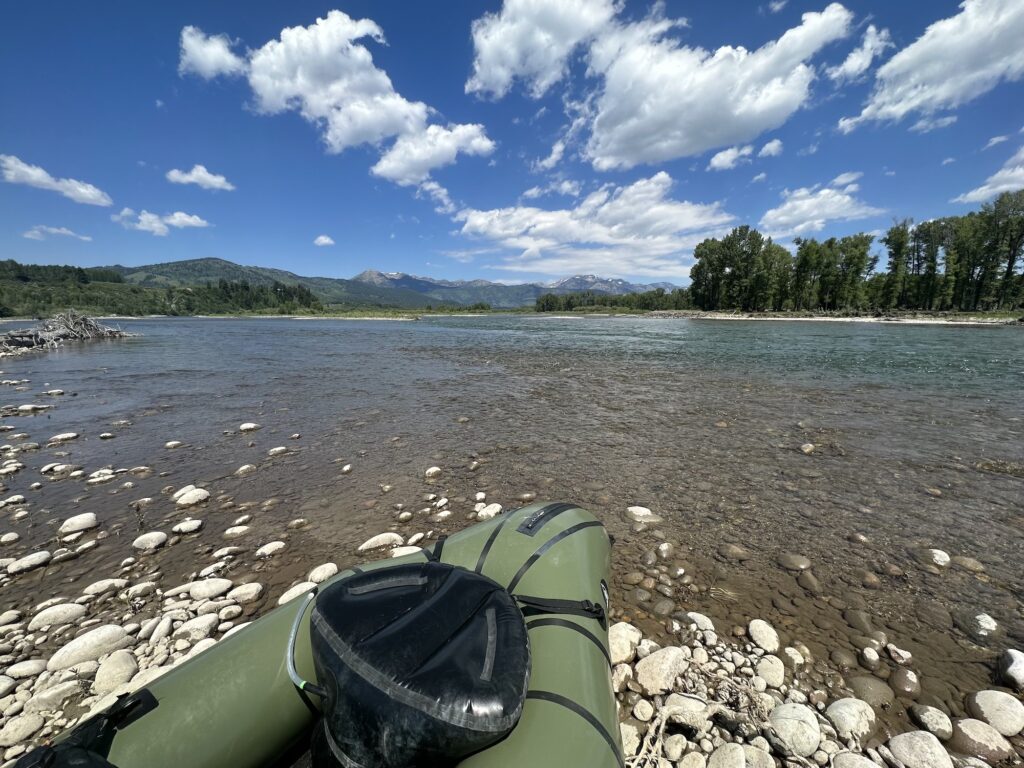
The river it was not so lazy. Fell out of the boat today. Not once but twice. You know those stories of people who murder their spouses in the wilderness and then claim their partner slipped while hiking? Today was like that minus the intent to murder. I think.
Went up and over Teton Pass to have a day on the Snake River. Perfect weather, stunning views. We had a big main raft, piloted by our able guide Justin, and then a smaller pack raft for two people. I was in the small raft with Robyn. We weren’t 25 yards off the boat launch — in admittedly the roughest part of the whole stretch — when she and I slammed into a highway bridge support. Our family was in the other raft on the opposite side of the piling. They saw two people head under the bridge in our raft — and only one emerge. I had been dumped overboard, you see, without any witnesses. Upside: she could have finished me off with the oar, but this did not happen.
It was actually quite refreshing and legitimately enjoyable dangling there under the raft until I could be hoisted back up. (I did lose my beloved 23-year-old Tilley hat.) But that was only the first spill. The second one, less fun.
After a shore lunch we rearranged the crew manifests and put my niece and I in the little raft. We got separated from the main raft on one of the countless oxbowing braids that eventually fed back into the main channel. Not a problem. The stretch we were on was narrower and thus faster and we had to maneuver around a lot of tree debris, but other than that we were having a fine time. Until we weren’t. We still don’t know what happened (though maybe we were distracted looking for shoreline moose?), but in an instant we were both flung from the raft and it flipped over. And now we were flotsam on a liquid conveyor belt moving far too fast for us to stop ourselves on the bottom. The good news is that millions of years of constant tumbling meant that the river rocks were perfectly smooth. Some battering but no slicing. (Except for the dead trees under the surface: those sliced.) But again, it was all moving too fast.
I was able to grab an overhanging branch at one point but could only hold on for a few seconds. The raft held by my other arm was a sail channeling all the force of the river. So I let go and down we went again. It was a little frightening at points, honestly, as I could not see my niece at all times on the other side of the capsized raft. So I asked her to keep talking. Only way to know if she were above water. We tried to swim for shore, but hydrodynamics said nope. Eventually two kind kayakers came from upriver and helped us onto a shoal where we were able to right ourselves. My watch immediately asked me if I would like to record an outdoor swim. Which, sure! It logged a workout time of 21 minutes, but I don’t think we were in the drink for that entire time. Maybe? Out of the water I was shivering uncontrollably. I’d guess the water was in the low 50s so I wasn’t in hypothermia territory, but still: freezing. And just then the main raft came around the bend. My niece and I were done with the little raft and Justin rowed us, huddled in dry towels, to the take-out. Through all that it was still extraordinarily fun. I feel like I know the Snake River now.
The pace of the trip has slowed as we’ve synched to the rhythm of people who actually live here. A denouement back into the real world — with a big party (final orchestra crash!) to end it all.
Up next: America’s birthday in a small town in a red state.
Day Fifteen – Field Laboratory
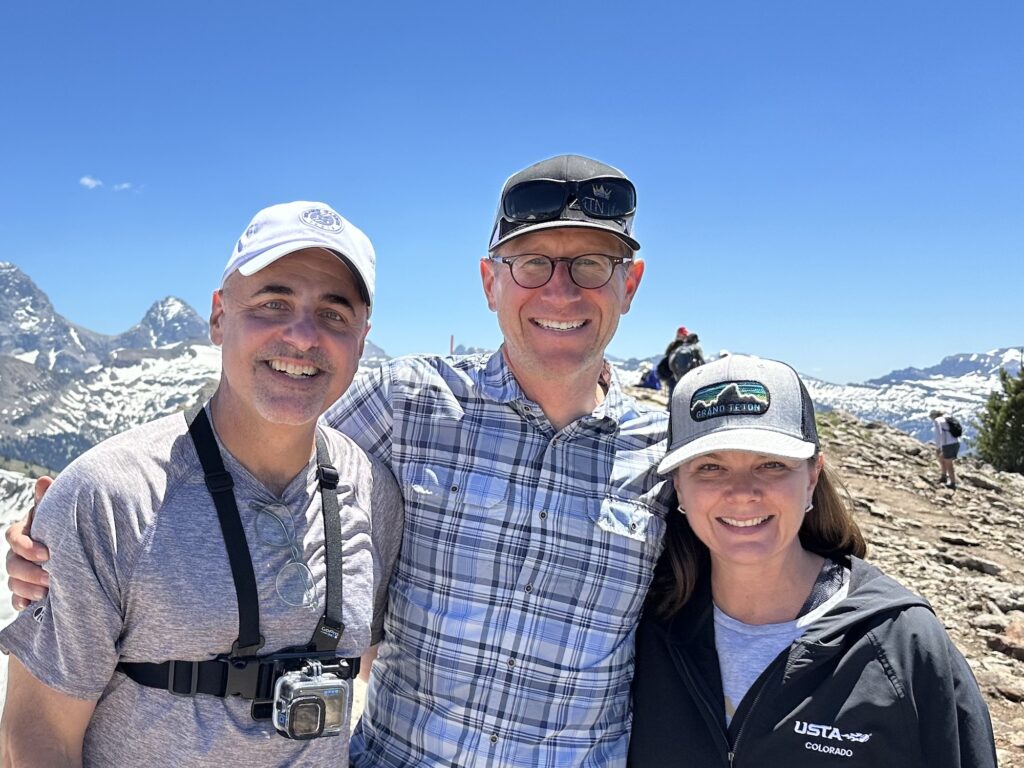
In the fall of 1990 I met the woman who would become my wife. This happened because a friend of mine, Justin, had assembled a Geology 101 study group in the middle of the hallway outside my room. (He had been locked out by his roommate who was using it for a romantic interlude.) In this study group was one Ms. Robyn Burke, who I almost stumbled over as I tried to negotiate past everyone sitting on the gross dorm floor. And that, kids, is how I met your mother.
33 years later we’re staying with Justin and his incredible wife and two kids in Victor, Idaho enjoying our own Geology 101 lab session. It’s a lovely almost-end to this odyssey, visiting an actual (and beautiful) home with close pals who know the area in great detail. Today we headed over to Grand Targhee to hike a bit and see the Teton range from the “other” side. It did not disappoint. Justin knew every little nook and cranny as he regaled us with tales of ice-climbing the peaks, the intrepid souls who ski backcountry through the protected wilderness, and just how wonderful it is to have a mountain on this side of the pass that is a completely different scene than Jackson Hole.
I’m spending these last nights in the trailer, actually, a slow goodbye to what is now a container of pure chaos. Over two weeks of travel and all our careful packing and stowage is now just a jumble of I-thought-I-saw-that-a-week-ago. But the dog and I are nested in it and all is good with the world. Got a taste of fireworks explosions last night and doggo was not at all pleased shaking his way to sleep basically on top of my face. May have to break out the CBD dog chews for July 4.
Next up: an actual lazy river float.
Day Fourteen – Fencing
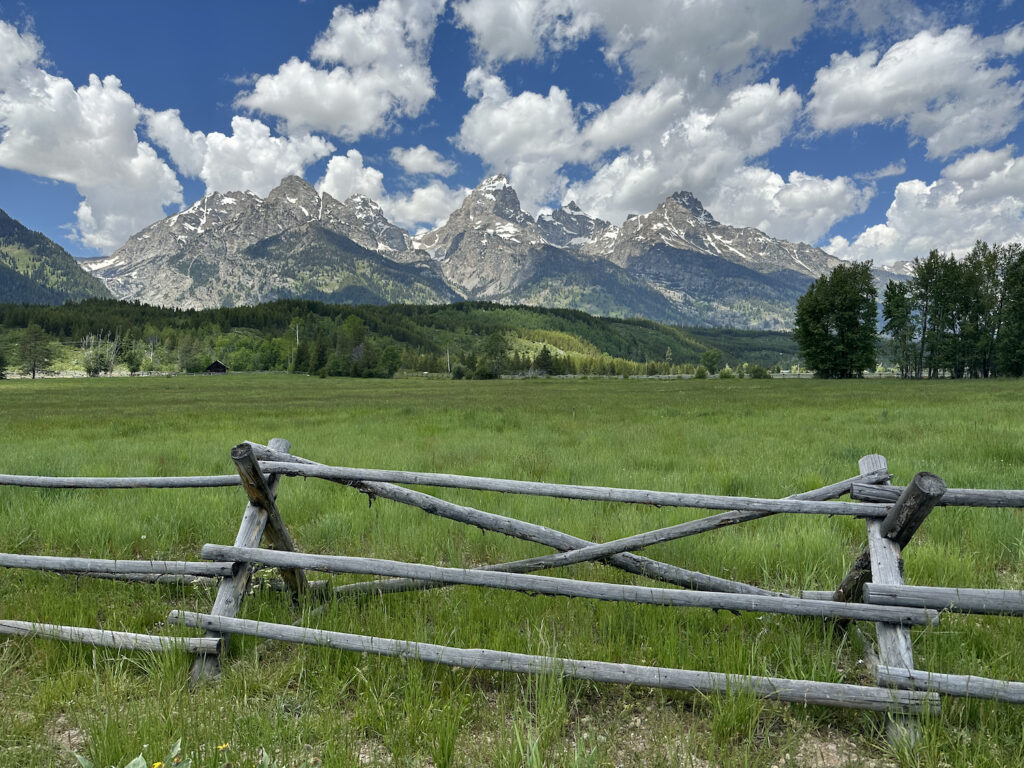
Spent a good part of today as middle-schoolers joking about horny French trappers and the etymology of “The Tetons”. And I mean all of us. It’s that part of the trip.
Our giggling safari crew had but a single destination today: Jenny Lake, the stunning thank you card the glaciers left at the foot of the range give-or-take 10,000 years ago. Ludicrously photogenic. We hiked a bit but mostly just frolicked at the lakeside. At one point I practiced steep slope bailout procedures with a makeshift Runaway Dad Ramp. I also learned about the concept of Frost Heaves. It was a fulfilling morning to say the least.
Our departure from the park was an extended search for the location of this photo, taken in 1978 on one of our motorhome trips of yore. (Those few of you who have followed this travelogue from the start know this search has been an ongoing sidequest.) Problem is that of the two defining features in this photo only one is basically immutable. The park service began removing and/or replacing the buck rail fencing about a decade ago. We think we found the place — or at least very near it. Whether this is the actual fence is up for debate. My sis and I are calling this mission accomplished. Thanks for the little game all these decades later, dad!
We spent the afternoon in a bustling Jackson, WY, a delightful mountain town that exists somewhere on the spectrum of tastefulness between Deadwood and Aspen. Not too cheesy, not too pretentious. Just go easy on the Huckleberry products and don’t Zillow any home. Mostly I was reminded that I’d like to return for dedicated fly fishing and ski trips here.
Meanwhile, back at the ranch, the trusty camper trailer sits forlorn and unused on its RV hookup pad at the cabin resort. Seems like years ago that we crammed ourselves into it. I should probably empty the septic tanks. She’s got one last run in her, of course, but that’s a few days from now.
Attempted some amateur astronomy with the ‘scope I hauled all the way out here. Good skies except for the waxing gibbous moon that shines like a flashlight, blotting out the good stuff. Hoping for better viewing conditions in a few days.
Next up: a college reunion.
Day Thirteen – Tetonia
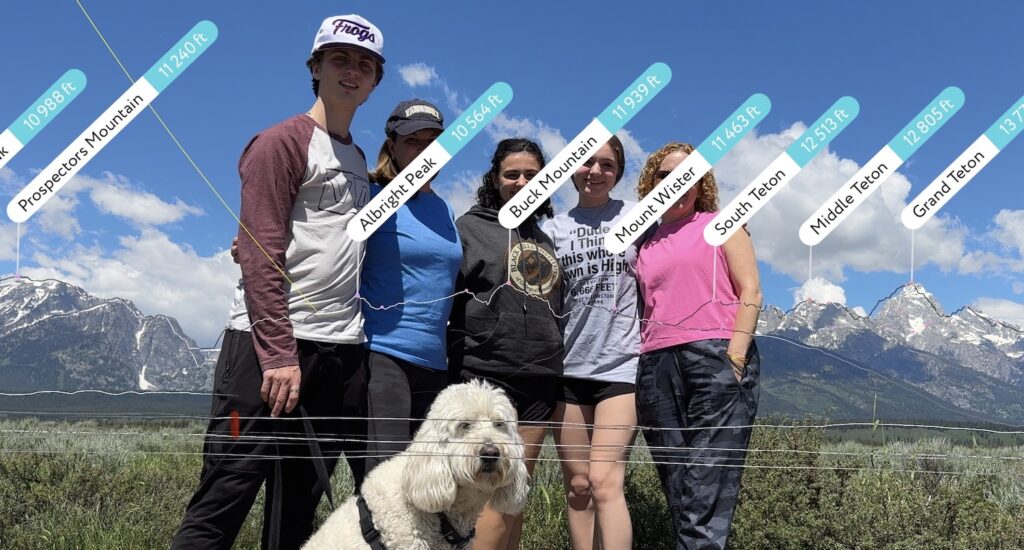
Let’s get the important update out first: I have been reunited with my my zip-off hiking pants, forgotten on departure, but delivered with the arrival of my wife and son. These pants are the ultimate old man accessory, first introduced to my family — to the horror of my siblings and I — on a trip to Rome in the 1990s. It was hot as blazes and Catholic churches there banned entry in shorts, but my father solved this with zip-off pants. No one looks like a tourist so much as a middle-aged man zipping on/off leggings next to a public fountain outside of a church, I say. Anyhoo, fast forward almost thirty years and I love these things. So convenient for the temperature swings of high elevation summers. And I’m here to say, like my father before me, my pantaloon transformation atop Signal Hill at Grand Teton today was just as mortifying for my children (and wife, and sister, and niece) as anything my father pulled off. +1 me.
It was a day of touring Grand Teton National Park. Starting with an actual sit-down brunch, grabbing delicious packed sandwiches for lunch, it is almost like there are actual adults on this trip now. We merry six (and dog) tooled around the park hitting an itinerary of sights assembled by my son and resisting the urge to take photos at every turnout. It’s almost comical how scenic this place is. None of the earth-on-fire drama of Yellowstone, but Grand Teton is majesty at nearly every turn. Perfect weather too.
My sister and I embarked on our search for the site of the buck rail fence photo we thought my father took at Big Timber (see Day Five and Day Eight). We got close, but it wasn’t exactly right. Pretty sure we know where it was taken now and will continue the search as we head back into the park. (We did find a cool “outtake” from my father’s slide roll way back when with a kind of self-portrait.)
Checked off two more animals today. We saw a coyote scampering across the road and into a meadow. You have to hand it to coyotes. Maligned by everyone from ranchers to city dwellers, these beasts are the only creatures of the plains whose numbers have increased in the last century. They are resourceful and adaptable, basically un-killable. I wish the same could be said about the pronghorn “antelope”. But we did spot a few way off in the distance thanks to my son. And then there was the bull elk without a care in the world munching foliage just inside the tree line off the side of the road causing a multi-car pileup of enchanted humans.
Next up: more Teton and a visit to the town of Jackson.



